| Home |
| Acknowledgments |
| Conventions |
| Glossary |
| Maps |
| References |
| Links |
| Articles |
| Thumbnails |
| Species
list |
| Family |
| Next
species |
Additional Photos
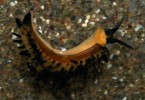
underside

side
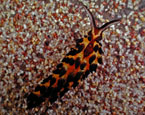
wide stripes
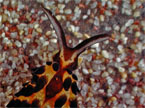
head detail

mucous secretion

on Derbesia sp.
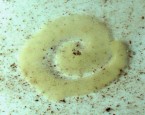
egg mass

Placida barackobamai McCarthy, Krug & Valdes, 2017
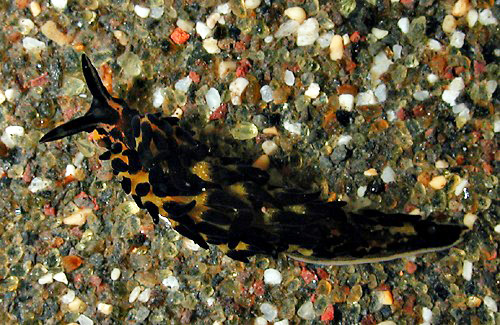
| Maximum size: about 14 mm. Identification: This species has a pale orange body with a few small cream flecks. The distal half of the cerata, the ventral surfaces of the rhinophores and the sides of the head are velvet-black. The rhinophores have sharply bounded, dorsal white stripes extending their full length (in contrast to the similar-appearing Placida kevinleei in which the rhinophores have diffuse white stripes confined to their bases). The width of the stripe is variable. (Note 1) Natural history: Placida barackobamai is a rare species found in moderately exposed to exposed rocky habitats at depths of 1-6 m (3-20 ft). It shows a diurnal activity pattern when held and secretes a very strong mucous "drag-line" when dislodged. It may also release opaque-white, defensive mucus when disturbed in a manner similar to some other sacoglossans. (Note 2) It lays a flattened, cream egg mass that hatches in about three days in the laboratory. According to McCarthy, et. al. (2017), it's been found to feed primarily on the filamentous green alga Derbesia sp. (Note 3) Distribution: Big Island, Maui and Oahu: widely distributed in the western & central Pacific. Taxonomic notes: It was previously lumped (with Placida kevinleei) under the circumtropical species Placida cremoniana (Trinchese, 1893). The latter, however, was recently found to be a species complex as reported in McCarthy, J.B., P.J. Krug & A. Valdes, 2017. It was first recorded in Hawaii from Hekili Point, Maui by CP on Oct. 27, 1997. Photo: CP: 11 mm, narrow stripes: Ulua Beach, Maui; April 2, 2005. Observations and comments: Note 1: Although the basic pattern remains constant, the amount of black pigment on the rhinophores may increase with age. Note 2: Narrissa Spies, referring to an animal about 14 mm in length found in a sea table at the Kewalo Marine Laboratory, reported that "...when we agitated it to move it away from the side of the dish for photos, it released a burst of iridescent blue mucus (this happened twice in response to our probing)." Note 3: McCarthy, et. al. (2017) suggests that its distinctive color pattern is aposematic coloration associated with the retention of toxins from its food algae. However, some of our animals were taken in beds of Sargassum echinocarpum and/or Sargassum polyphyllum. If that proves to be its primary habitat, perhaps the orange and black coloration actually evolved as camouflage when crawling on Sargassum spp.? Presumably, the filamentous Derbesia is growing on or under the larger algae... |
| Thumbnails |
Species
list |
Family | Next species | Top |